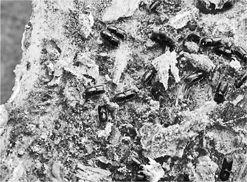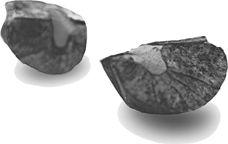Insectopedia (52 page)

Listen. Can you hear it? With the soundscape we take tentative steps into a wider, richer world.
But more than just the sound of life in trees, the soundscape is the soundtrack to an epidemic. These noisy beetles are not merely symptoms of global warming, say Dunn and Crutchfield; they are also its cause. Dunn and Crutchfield see forest dynamics as a cybernetic feedback
loop accelerating under conditions of climate change. With their relentlessly successful adaptive population dynamics, the insects drive the system past equilibrium. Decisive in felling the forests and so releasing carbon stored in tree biomass and captured during tree growth, bark beetles become the accelerating motor of what Dunn and Crutchfield call “entomogenic climate change.”
21

It is an intriguing insight. But in practice it is likely to make little difference to the Scolytidae and their bark-piercing allies. Already there is little hesitation from any quarter in holding beetles responsible for the deforestation overwhelming so many North American forests, in understanding their behavior as “infestation” and “invasion” (folding these anxieties into persistent fears of human immigration), and in working to eradicate them.
Listen. These sounds provoke complicated responses. The beauty of that rich interior life, the music of the phloem—it is self-contained, indifferent, the soundtrack to catastrophe. These beetles live fully communicative lives, their
Umwelt
is thoroughly social. These are not the enemies we ought to choose. The biosecurity state, with its traps, its pesticides, its arborists, its public-education programs, and its quarantined counties, is largely powerless. It was Mao Zedong, apparently, who said that where there is repression, there is resistance. He wasn’t thinking of insects. But we should be. As far back as twenty-five years ago, 7 billion beetles were caught in pheromone traps during a campaign to repulse an invasion of European spruce bark beetles in Norwegian and Swedish forests.
22
Seven
billion
, and still they kept coming. Repression is futile. Somehow, we will have to cohabit. Somehow, we will have to make friends.
x
Libris, Exempla
Excess
December 26, 1934. A famous episode in the history of Surrealism. In a Paris café, André Breton and the up-and-coming writer Roger Caillois quarrel over two Mexican jumping beans.
* * *
Three years later, Caillois founded the Collège de sociologie with two other dissident Surrealists, Georges Bataille and the anthropologist Michel Leiris. (He also participated, halfheartedly, in the charismatic Bataille’s Acéphale [Headless] group, a secret society whose few members, the story goes, having reached agreement on the radical gesture of a human sacrifice, found plenty of volunteers among themselves to play the victim but none to perform the execution.)
1
Two more years passed, and Caillois left France to sit out the Nazi occupation in Argentina. Nine years after that, he began a career as a cultural bureaucrat at UNESCO. Twenty-three years later, he was elected to the Académie française. Along the way, he wrote a series of erudite, idiosyncratic, and barely remembered books on unusual topics, among which insects—and in particular praying mantises, lantern flies, and other masters of mimicry—held a special place.
* * *
Sometime on December 27, 1934, perhaps nursing a hangover (he was twenty-one), Caillois sent a letter to Breton in which he declared his break with Surrealism. “I had hoped,” he wrote, “that our two positions were not as deeply divided as they turned out to be during our conversation yesterday evening.”
2
* * *
The enigmatic beans sat in front of them on the table. Why did they jump like that? Were those irregular twitches a symptom of some strangely suspenseful life force? Caillois took his knife to break them open. Breton, nearly twice his age, recently expelled from the Communist Party, the author of the Surrealists’ founding manifestos, a prominent figure in French intellectual life, made him stop.

They knew that each bean contained a larva of the
Laspeyresia saltitans
moth and that its spasms were the creature’s movements inside its hollowed shell. But Breton didn’t want this type of confirmation. “That would have destroyed the mystery, you said,” wrote Caillois.
3
* * *
Caillois described the dispute as between poetry and science. But his science was distinctively poetic even then. He threw himself into the “utter confusion” that he identified as the hallmark of inquiry in a contemporary world characterized by “the
debacle of the evident.
”
4
Like any good scientist, he saw confusion as a provocation to systematic inquiry. But he was developing his idea of “diagonal science,” “the science of what exceeds knowledge,” a science that would encompass “what science doesn’t want to know.” He was in search of “an order that will allow disorder itself to enter into the order of things.”
5
Revealing the larva inside the bean would hardly end the mystery, he wrote to Breton: “Here we
have a form of the Marvellous that does not fear knowledge but, on the contrary, thrives on it.”
6
* * *
The natural world is full of marvels. Maria Sibylla Merian came across one in Suriname. The lantern fly,
Laternaria phosphorea
, she discovered, creates enough light by which “to read a book printed with the same type as that used for the
Gazette de Hollande.
”
7
Actually, she was mistaken; the lantern fly creates no phosphorescence—an odd, uncanny mistake that affixed itself to the insect for more than 100 years and lives on in its Linnaean name. Caillois suggests that the appearance of this creature so surprised Merian that she unconsciously made sense of it by the substitution of a different, unrelated strangeness, the strangeness of animal luminosity.
And
L. phosphorea
is a startling animal. Like the praying mantis, it fills the world around itself with myth, storytelling, and legend. Henry Walter Bates, the British naturalist who lived eleven years in the Amazon basin and discovered, among many other things, a form of butterfly mimicry crucial to Darwin’s theorization of natural selection, retold stories that circulate in the region about lantern flies that attack and kill men on the rivers. In Amazonia, Bates says, the insect is known as the crocodile head because of its long, snoutlike proboscis.
8
This empty box extends from its face and “imitates an alligator’s head exactly,” writes Caillois (who was not really one for biogeographic precision); “color and relief combine to simulate the savage teeth of a powerful jaw.” The effect is “absurd, even ridiculous,” but undeniable.
9
How strange that a small fly that lives among the trees should have this resemblance and, accordingly, such power to intimidate.
* * *
There is, Caillois proposes, “a repertoire of frightening appearances,” a set of prototypes in nature upon which both the crocodile and the lantern fly draw. Mimicry is not about disappearance, about hiding in plain sight. It’s more often the capacity to reappear, to induce panic
by the sudden substitution of one appearance by another, like a Haida shutter mask. Out of nothing, out of empty space, the praying mantis abruptly rears up over its prey, revealing its intimidating eyespots, emitting sinister sounds; its victim is rooted, paralyzed, hypnotized, incapable of fleeing its presence, and the mantis “seems supernatural, unrelated to the real world, coming from the beyond.”
10
And so does the lantern fly. Behind its reptilian “false head, dwarf and giant at the same time,” Caillois makes out another head, “the tiny head of the insect,” with its “two bright, black, almost microscopic points—the eyes.”
11
The crocodile face is a mask, a mask that corresponds in its effect and method of use to the mask of the human shaman. The lantern fly “behaves like a spell-binder, a sorcerer, the wearer of a mask who knows how to use it.”
12
* * *
Caillois was a dedicated collector of rocks and stones. Toward the end of his life, he published
The Writing of Stones
, a lavishly illustrated guide to the highlights of his collection, in which he describes each stone with his singular combination of biological reason and analogical poetics. He finds the same kinds of correspondences in stones as those that draw him so relentlessly to insects. Just as insect mimicry shares the decisive characteristics of sorcery, just as the animal’s mimetic ornaments are equal in practice and effect to the shaman’s mask, just as the alarming eyespots on the wings of the
Caligo
butterfly call to mind the evil eye (“The eye is the vehicle of fascination in the whole animal kingdom”), so the gorgeous stones of Caillois’ collection—“and not only they but also roots, shells, wings, and every cipher and construction in nature”—share, along with the human arts, a “universal syntax,” a connection to the “aesthetics of the universe.”
13
If categorical segmentation is always the first step in scientific reasoning, this is a world that at all times exceeds its compartments. It is the dissolution of boundaries—self, other, body, animal, vegetable, mineral. The dissolution into space. At the end of one of his most famous essays, Caillois quotes the final ecstasy from Flaubert’s
The Temptation of Saint Anthony
, “a general spectacle of mimicry to which the hermit succumbs”:
“Plants are no longer distinguished from animals.… Insects identical with rose petals adorn a bush.… And then plants are confused with stones. Rocks look like brains, stalactites like breasts, veins of iron like tapestries adorned with figures….”
Anthony, writes Caillois, “wants to split himself thoroughly, to be in everything, ‘to penetrate each atom, to descend to the bottom of matter, to
be
matter.’”
14
The inky-smoky-vibrant polished surfaces of jasper and agate can take Caillois there. A riled hawk moth can take him there. A rearing mantis can take him there. A lantern fly can take him there. “No one,” he writes, “should say it is nonsense to attribute magic to insects.”
15
Writing from what is now Mexico City, the Franciscan chronicler Juan de Torquemada described how, after Hernán Cortés had taken Moctezuma II prisoner in the Aztec ruler’s own palace in 1520, the conquistador gave his men free rein to explore the royal compound. Among the Spaniards’ discoveries, wrote Torquemada, were a number of small bags, which they at once assumed were filled with gold dust.
When they cut the bags open, the Spanish were dismayed to find that instead of gold, they were filled with lice. In Torquemada’s story—a story he attributes to two of Cortés’s lieutenants—the lice were an expression of the profound sense of duty that even the poorest of the emperor’s subjects, those with nothing else to offer him, felt toward their sovereign.
16
Torquemada credited the discovery of the bags to Alonso de Ojeda, the notoriously brutal governor of Urabá who accompanied Columbus on his second voyage to the Indies. But Ojeda had died five years earlier, in Santo Domingo, following a rout by Indians at Cartagena and a subsequent shipwreck. If Torquemada, writing nearly a century after the event, was wrong about Ojeda, perhaps he was mistaken about other details too?
* * *
In another version of this story, the lice made their way to the palace through the efforts of elderly people conscripted for the task by Moctezuma. Incapable of more onerous duties, these men and women were charged with visiting their neighbors’ houses, delousing the occupants, and delivering their bounty to Tenochtitlán as tribute. Given that the earliest medical text from the Americas—the Aztec codex of 1552 (unearthed in the Vatican in 1931)—lists indigenous herbal treatments for head lice, phthiriasis (eyelid lice infestation), and “lousy distemper,” it could be that this tribute was an initiative of imperial public hygiene.
17
